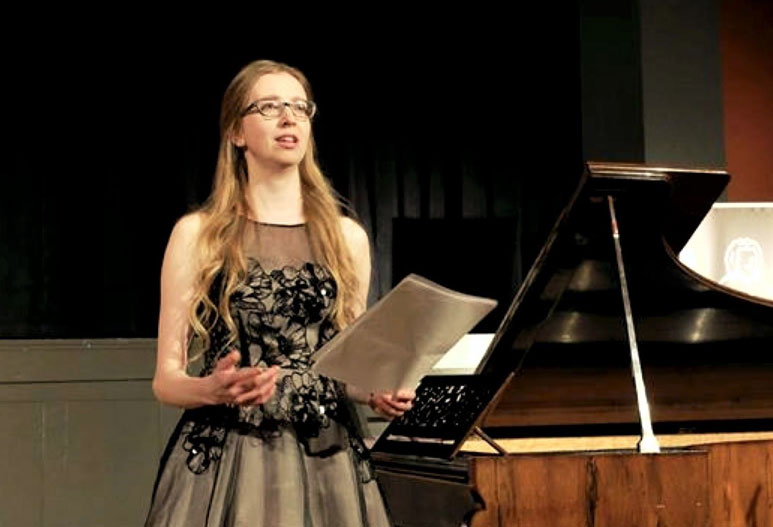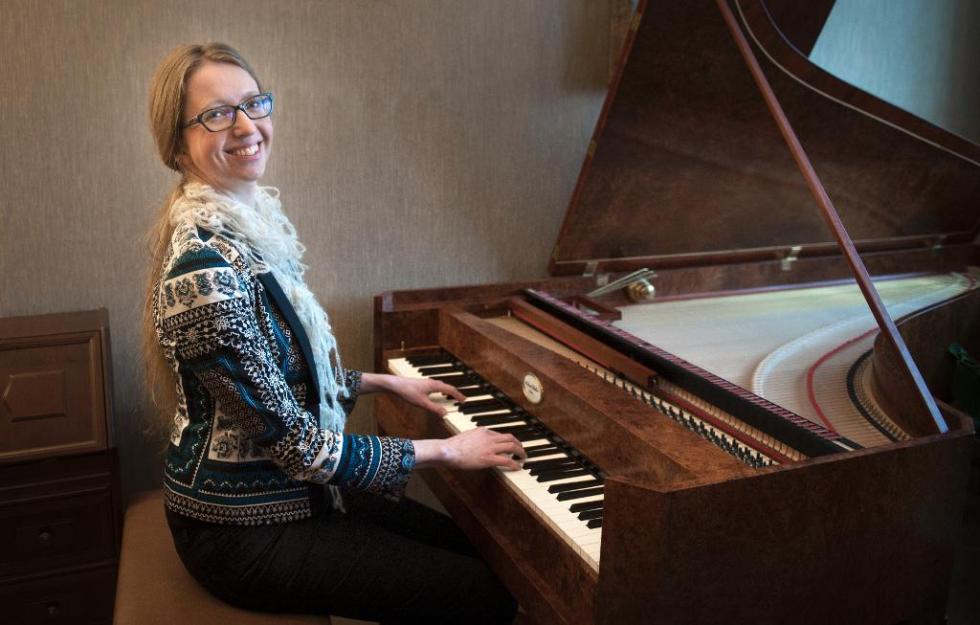News From the Past: Can We Play Like Schubert Did?
Christina Kobb is a Norwegian pianist and researcher, specializing in Viennese fortepiano performance. Her research now focuses on practically reconstructing piano technique from the early romantic era. How did Schubert, Chopin and the other masters manage before the free-arm-technique became the norm?
It was different 100 years before when Mozart was making a world tour as a youngster. Instead of being hunched over the piano crashing one’s weight down upon it, performers were required to sit ramrod straight and keep their arms and elbows at their sides. Most playing was finger-driven with supple wrists that were raised and lowered with great delicacy. Tchaikovsky’s racing octaves, Rachmaninoff‘s gigantic block chords and Liszt’s monumental tonal constructions were notably absent from pieces composed at that time.
Christina Kobb, who is heading up a project to promote 18th-century playing, such as might have been practiced by Mozart, notes that it is easier to play running 16th notes faster. It’s also simpler to play chords more accurately and smoothly. She maintains that pianists should, at the very least, familiarize themselves with the techniques to get better in touch with the thoughts and aspirations of the composers of the time.
Piano Street met up with Christina to talk about her research.

Piano Street: Since we last spoke about 18th century piano playing your continuous research has been dealing with the execution of basic motions in piano playing from the early 19th century. Can you tell us a little bit about your work?
Christina Kobb: In 2008, I began my PhD project on historic performance practices at the Norwegian Academy of Music in Oslo. I had already been specializing in historical keyboard instruments for several years, and was eager to understand more about piano playing in the 1820s – one of the most successful decades in the history of the piano! In a quest to find out more about how Beethoven, Schubert, Hummel and other great pianists of the early 19th century may have played, I studied the piano treatises of this time. Penned by leading pianists like Johann Nepomuk Hummel, these pedagogical works offer insights into ideals and preferences for performance. What I did differently than most other researchers, however, is that I focussed on the instructions for basic body posture and arm/finger motions.
PS: Which were your conclusions?
At first, it seems rigid and exaggerated to follow obsolete rules like sitting bolt upright, keeping the elbows close to the body while playing and moving the fingers only from the middle of the finger. Nevertheless, since even my very first attempts produced a much better tone in the fortepiano – and even in the modern piano. In the years since, I have reconstructed the basic piano technique described in Viennese sources of the 1820s and used myself as a lab rat by retraining my body to comply with the old instructions. Most interestingly, though, these changes have also encouraged a change in how I play the music – even how I shape each phrase. To me, this is the most fascinating discovery: How a pianist’s body, hand and finger motions directly translate into sound. Does this mean that I now play exactly like Beethoven? Probably not! However, one might well argue that a piano technique reconstructed from the sources of his day will bring us much closer to the ideals of his time than what any modern piano technique will.

PS: When listening to historical instruments performances, I have a feeling that we forget the professional and social context of the keyboard player. The ”concert pianist” – in the sense that one player is on stage playing works by other composers – isn’t really invented until Franz Liszt and Clara Schumann. Also concert halls were smaller. Which were the requirements for functioning as a pianist performer in the 1820s?
CK: I love this question and your very good point, which I find is asked way too seldom! The problem is, unfortunately, that I do not have a satisfactory answer. But to name a few things – firstly, it would have been unthinkable to play just one instrument. Professional musicians could sing, conduct and play strings and keyboard instruments. Secondly, the theoretic schooling was extremely thorough (in the German-speaking area), and the integration of aural skills a matter of fact. Just think about it, many composers never got to hear their greatest works! Yet, they knew exactly how it sounded and how to orchestrate. Their musical imagination must have been so fine-tuned and highly developed that we, “mere pianists” of today, would probably be regarded amateurs in their eyes. To make it as a pianist composer in the 1820s, you would have to compose pieces in your own unique style, and sell copies of the scores to your fans – who would do their best to play it at home. And to really win the hearts of your audience, you had to show great improvisation skills. It was highly valued to create something for the moment – be it in improvisation or in the rendering of a composition. But sadly, the art (or even attempt!) of touching the listener is often lost in modern music making, even on historical instruments. Personally, I find this loss far greater than missing a few slurs or playing a “wrong” ornament. Lack of emotional depth makes us lose interest in actual listening. It would be both historically correct and of timeless value to re-emphasize touching performances of classical music!
PS: How can ”modern piano playing” benefit from knowledge about old style piano playing?
CK: First of all, playing historical pianos makes us aware of diversity of sound. This is quite an experience, compared to the current “standardized” sound resulting from the Steinway-dominated market. Nevertheless, we all know that a piano can sound strikingly different under two different pairs of hands. How a piano is played is at least as important as how it is built. Pianists nowadays typically play with much weight, passion and brilliance, – qualities encouraged by big concert halls, large sonorous grand pianos and modern repertoire. Nevertheless, the core repertoire of most pianists (and most concert programmes) still tends to be classical and romantic piano works. The intimate feeling often required in these pieces thrives on a lighter touch, elegance of phrasing, exploration of sound colours and softer dynamics. My reconstruction of the old Viennese piano technique offers all of this, and can, to a great extent, be used in modern piano playing as well. Knowing how piano playing once looked like, and what kinds of sound and phrasing it fostered, will enrich interpretation. Performing solo piano works is demanding, and we need all the tools we can get! I do hope that my research can make people aware, once again, of what we have nearly lost, and use it to create more beautiful, more interesting performances. I should also mention that one important bonus of the upright posture required in 19th-century technique is disappearing pain. Unfortunately, many pianists struggle with arm and back pains, and I was no exception. However, a decade of improving my posture seems to have solved the problem completely! Good posture simply allows for more practice without ruining your body.

PS: You have investigated historical piano playing and the development of the piano as an instrument is a consequence of how it was needed to be played. In your opinion, what was gained and lost in our musical conception during the trip from the fortepiano to the modern concert grand?
CK: The question of changes in musical conception is probably the most important question, and the instrument change may only be one indication of the overall change in aesthetics.
I’m afraid we have lost improvisation, and with it, the touch of creation while performing. We have gained standardisation in keyboard building as well as in playing, but sadly, lost delicacy and nuance, as well as clarity of tone and phrase. We might have gained exactness in the metronomic sense, but I’m afraid we have lost rhythmic definition and the ‘speaking qualities’ for which renowned masters of the fortepiano once were known. Intimacy was lost with the big concert halls – volume was gained in the attempt of filling them.
For me, so enthralled by 19th-century music and pianos, I must admit that I feel we have lost more than we have gained. But even so: During all of this, we have really established the piano as a solo instrument as well as the instrument for music lovers all over the world. This is something that Mozart and Beethoven could only have dreamed of! For us pianists, it is a major gain that so much of the music we play is commonly known. And if we really want to, we can bring back the elements that have been lost and bring about a new era of beauty in piano playing. I do think it is possible, even on the modern piano – which I attempt to demonstrate in this video:
PS: Thanks for the conversation and good luck with your continuous work!
CK: You are welcome!
Read more on musicandpractice.org
Comments
Viennese pianos from the early 19th century and before did not have double escapement. What limits does this place on trills and repeated notes?
Metronome marks. such as we have, often do not match the written score, however if the music is too slow the notes are not sustained, but some very fast indications seem to be impossible either because notes cannot be made to sound so quickly or are beyond what any pianist has ever played or are simply unrealistically unmusical (such as Czerny’s Bach). So what is the best guide for the tempo?
A beautifully researched article, highlighted by the excellent video Ms. Kobb presented, with her convincing examples of appropriate 19th century technique in repertoire by Beethoven, Schubert and Chopin.
Great tips, excellent playing; inspirational.!!!
I need to go back to my keyboard and practice.
Thanks
I very much appreciate the comments in this interview. Mozart and Beethoven were my great loves as a boy. The Pano Concertos of both sing with such joy, and the tenderness and all the expressions are the reason for the existence of the music. The music was written for a world of people who loved music as a living thing; like healthy and nourishing food. I have a bit of a thing against musc competitions because they make the singer or the player more important than the spirit that the music is required to convey. Some “modern” pianists are quite classical. Horowitz and Rubinstein sat with erect postures and their fingers did the work. Chopin also must have been classical, as he could play quietly but very fast, and he disliked big public displays of showmanship. All best wishes, Jonathan Rutherford
A great read !
Piano ergonomics. Insteresting how the rubato comes organically out of the posture in the Chopin. Bravo!
As with all historical enquiry, it’s important to ask who is saying what to whom and why, in order to avoid tacit assumptions. I’m afraid there are many here. Christina Kobb assumes, for example, that those who played well adopted the techniques advocated by those who wrote treatises, and even that those who wrote treatises followed their own advice. She assumes that teachers knew what they were doing when they taught, and that their students folowed their advice. These assumptions seem unfounded to me. There seems to be a chronic disconnect between pedagogical dogma and practice in all time periods. I and my friend had the same teacher for the same length of time, and yet our approaches to playing are completely different. It seems to me from the video demos that the ways in which Christina Kobb is attempting to play (based on dogma from the treatises) is possibly not entirely how she is actually playing.